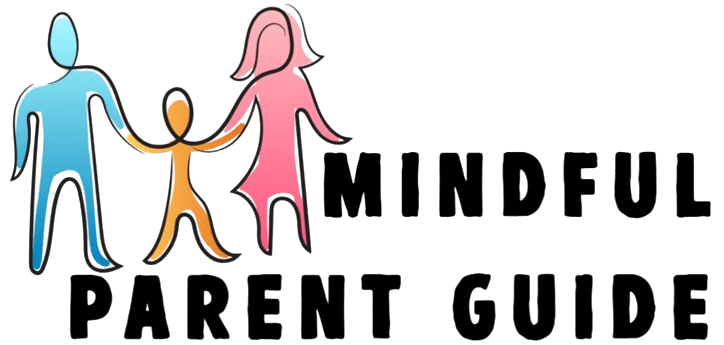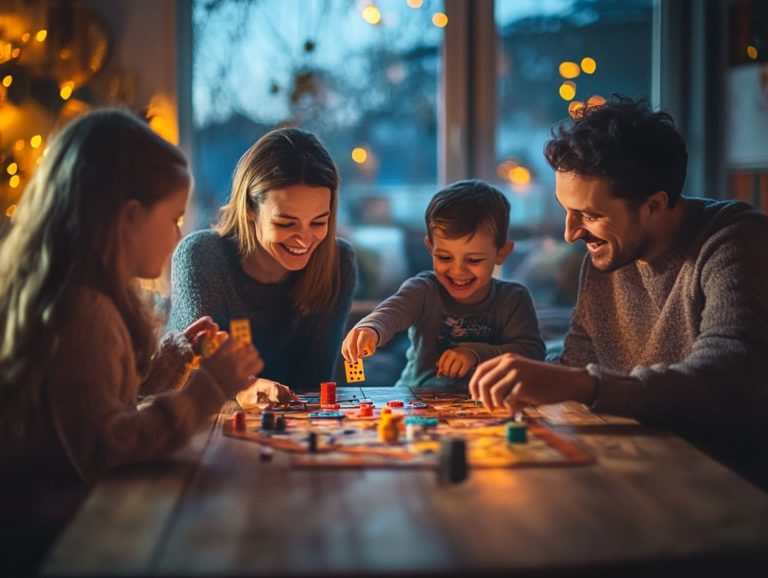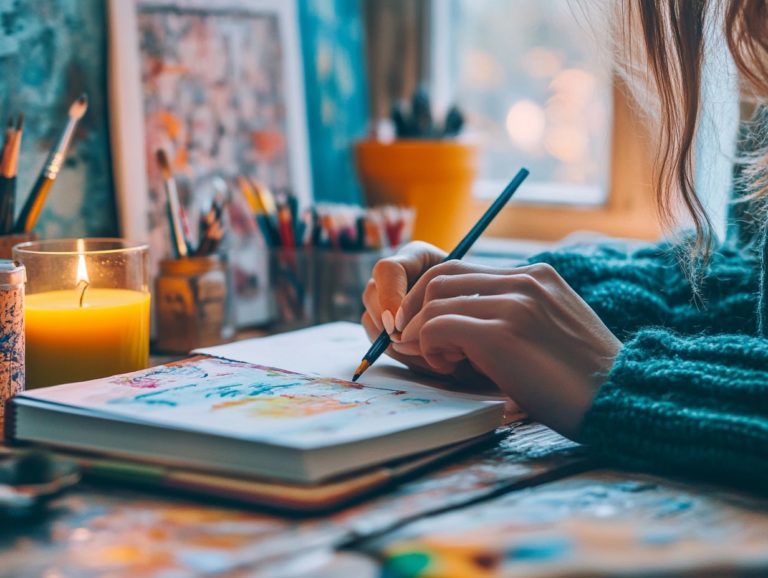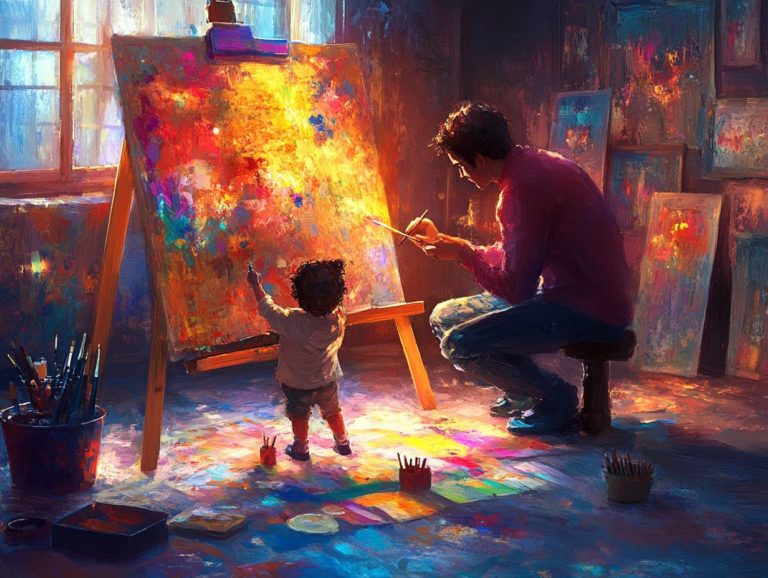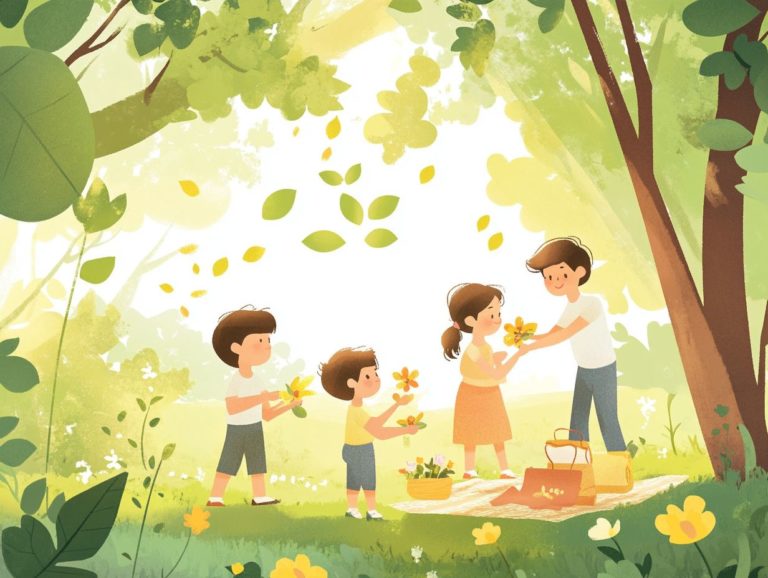5 Books for Teaching Kids about Mindfulness
In today s fast-paced world, filled with endless distractions, teaching kids mindfulness has become absolutely essential. Books like “My Body Is a Rainbow” and “The Rabbit Listened” offer great starting points.
Here are five remarkable books designed to nurture mindfulness in children, making the practice both accessible and enjoyable. From Eline Snel s engaging exercises to Thich Nhat Hanh s serene lessons, including “A Handful of Quiet,” these resources equip both children and parents with valuable tools for cultivating mindfulness.
You ll also discover the myriad benefits of mindfulness, innovative teaching methods, and ways to seamlessly weave these practices into daily life, whether at home or in the classroom.
Embark on this journey to foster calmness, focus, and emotional resilience in the next generation. Learn how stories like “The Three Questions” and “Munchy and Jumpy Tales” can make mindfulness relatable for kids.
Contents
- 1. “Sitting Still Like a Frog: Mindfulness Exercises for Kids (and Their Parents)” by Eline Snel
- 2. “Master of Mindfulness: How to Be Your Own Superhero in Times of Stress” by Laurie Grossman and Angelina Alvarez
- 3. “Breathe Like a Bear: 30 Mindful Moments for Kids to Feel Calm and Focused Anytime, Anywhere” by Kira Willey
- 4. “Mindful Me: Mindfulness and Meditation for Kids” by Whitney Stewart and Stacy Peterson
- 5. “A Handful of Quiet: Happiness in Four Pebbles” by Thich Nhat Hanh
- What Is Mindfulness and Why Is It Important for Kids?
- How Can Mindfulness Help Kids with Their Emotions and Behavior?
- What Are Some Fun Ways to Teach Kids About Mindfulness?
- How Can Parents Incorporate Mindfulness into Their Child’s Daily Routine?
- What Are the Long-Term Benefits of Teaching Kids About Mindfulness?
- What Are Some Common Misconceptions About Mindfulness for Kids?
- Frequently Asked Questions
- 1. What Are the Top 5 Books for Teaching Kids About Mindfulness?
- 2. What Age Group Are These Books Suitable For?
- 3. How Can These Books Help Children Learn About Mindfulness?
- 4. Are These Books Helpful for Children with Anxiety or ADHD?
- 5. Can These Books Be Used in a Classroom or Group Setting?
- 6. Are There Any Resources for Parents and Teachers to Accompany These Books?
Key Takeaways:
- Teach kids mindfulness through engaging books like “Sitting Still Like a Frog,” “Breathe Like a Bear,” and “I Am Peace.”
- Mindfulness can help children manage their feelings and behavior, improving their overall well-being. Stories like “Charlotte and the Quiet Place” effectively illustrate these concepts.
- Parents can incorporate mindfulness into their child’s routine through fun activities, such as yoga from “Our Family’s Doing Yoga,” and by modeling the practice themselves.
1. “Sitting Still Like a Frog: Mindfulness Exercises for Kids (and Their Parents)” by Eline Snel
In the captivating realm of Eline Snel s ‘Sitting Still Like a Frog’, mindfulness is presented as a vital tool for both children and their parents. The book elegantly intertwines understanding and managing feelings with breathing exercises, fostering a sense of self-awareness and empathy.
Moreover, the MindUP Curriculum by the Hawn Foundation and resources from EmpoweringEducation.org offer structured approaches to mindfulness. It invites children to embrace the present moment while encouraging families to engage in mindfulness activities that nurture calm and connection.
Key exercises, like the ‘Frog Exercise’, offer children a delightful opportunity to experience the power of deep breathing, visualizing themselves as serene frogs, which provides a charming pathway to quiet their minds. Join your children in these practices, creating shared experiences that strengthen familial bonds.
Mindfulness coloring is another engaging activity where families can gather to color, focusing on the sensations and hues before them. This practice not only enhances emotional regulation but also allows children to express their feelings through art.
Practicing gratitude together by sharing three things you are thankful for at the end of each day can deepen self-awareness and foster positivity, helping children understand and appreciate their emotions on a richer level.
2. “Master of Mindfulness: How to Be Your Own Superhero in Times of Stress” by Laurie Grossman and Angelina Alvarez
In “Master of Mindfulness,” authors Laurie Grossman and Angelina Alvarez invite you to enable your kids to become their own superheroes by exploring the remarkable power of mindfulness. This transformative guide focuses on essential coping skills that help them manage stress and navigate their feelings with confidence.
It enhances their social-emotional learning and equips them with the necessary tools for emotional regulation in various situations. Among the strategies highlighted, you ll find techniques like deep breathing exercises and the practice of gratitude, offering your children accessible methods to ground themselves during overwhelming moments.
For instance, if your child feels anxious before a big test, they can utilize the ‘5-4-3-2-1’ grounding technique to connect with their surroundings and ease their anxiety. Incorporating daily mindfulness routines whether it s a mindful walk or engaging in creative art fosters resilience by reinforcing the idea that emotions are both valid and manageable.
These practices not only promote self-awareness but also enhance interactions with peers, as your children learn to articulate their feelings more effectively, thereby improving their social skills.
Start your mindfulness journey today and explore these valuable resources with your children!
3. “Breathe Like a Bear: 30 Mindful Moments for Kids to Feel Calm and Focused Anytime, Anywhere” by Kira Willey
Kira Willey s ‘Breathe Like a Bear’ invites you to explore 30 delightful mindful moments designed specifically for children. These moments cultivate calmness and enhance focus in a way that is both accessible and engaging for young minds.
Through playful breathing exercises and imaginative scenarios, this book helps kids practice emotional regulation anytime and anywhere, promoting their overall sense of well-being.
Each exercise encourages children to visualize calming images or mimic the behaviors of animals. For example, the “Bunny Breath” teaches quick inhales followed by a long exhale, helping them find relaxation and concentration.
As a parent, you can play a crucial role by integrating these exercises into daily activities, whether it s before bedtime or during moments of stress. Incorporating books like “My Magic Breath” can make this process even more engaging.
Setting aside dedicated time for these practices, framing them as a fun game or a quiet moment spent together, helps establish a routine that reinforces emotional awareness and self-regulation. This ultimately guides children toward a more balanced emotional landscape.
4. “Mindful Me: Mindfulness and Meditation for Kids” by Whitney Stewart and Stacy Peterson
In “Mindful Me,” authors Whitney Stewart and Stacy Peterson offer a thoughtful journey into the enriching practices of mindfulness and meditation. They help you cultivate self-awareness and deepen your connection to your feelings.
This beautifully illustrated book invites you to explore your inner world and harness the transformative power of mindfulness as a tool for emotional growth.
The text introduces a variety of techniques, including deep breathing exercises, body scans, and visualizations. These are tailored for younger audiences, making the concepts accessible and relatable.
You can also find additional techniques like mindful listening and guided meditations in “No One But You” by Douglas Wood and “The Other Way to Listen” by Byrd Baylor and Peter Parnall.
With playful language and engaging activities, you ll discover how mindfulness can enhance emotional regulation and foster a sense of calm amidst life s chaos.
The vibrant illustrations elevate your reading experience, capturing your imagination and helping you visualize your thoughts and emotions more clearly. This harmonious blend of narrative and art keeps your interest piqued and reinforces your understanding of how to weave these valuable skills into daily life.
5. “A Handful of Quiet: Happiness in Four Pebbles” by Thich Nhat Hanh
Thich Nhat Hanh s ‘A Handful of Quiet’ gently introduces you to the concept of mindfulness. It presents a simple yet profound practice involving four pebbles, each embodying essential qualities for happiness and emotional regulation.
This charming book invites children to meditate and reflect, fostering a richer understanding of their feelings and the present moment.
You can easily incorporate the four pebble practice into your family’s daily routines, making it an engaging and educational experience.
The first pebble represents ‘calm’, serving as a gentle reminder for children to pause and take deep breaths when they feel overwhelmed. Imagine a child visualizing the calm pebble during a hectic school day, allowing themselves a moment to reset.
The second pebble symbolizes ‘compassion’, teaching kids the importance of empathizing with others’ emotions. Sharing stories about helping a sad friend can make this more relatable.
The third pebble embodies ‘joy’, encouraging children to pinpoint what truly brings them happiness. They could create a joy jar filled with prompts that spark smiles and laughter.
Lastly, the fourth pebble stands for ‘freedom’, inviting children to release negative thoughts. An effective exercise is to write down worries and throw the paper away to feel lighter.
Through these practices, families can strengthen their bonds and cultivate a more mindful environment, contributing to emotional well-being and resilience. Incorporating stories like “Tomie dePaola s “The Quiet Way” into your reading routine can reinforce these practices.
What Is Mindfulness and Why Is It Important for Kids?
Mindfulness is all about being fully present and aware of your thoughts, feelings, and surroundings. For kids, this skill is essential as it fosters emotional regulation, enhances self-awareness, and cultivates empathy in their interactions with others.
By engaging in mindfulness, children learn to navigate their feelings and develop coping skills that are vital for their journey in understanding emotions and relationships.
This practice involves several key components, including observation, non-judgment, and acceptance, which enable children to recognize their emotional states without becoming overwhelmed.
Research shows that when children participate in mindfulness activities like deep breathing or guided meditations they boost their concentration and demonstrate greater resilience in challenging emotional situations. The teachings of Melissa Taylor in “Mindfulness for Kids” highlight these benefits through practical activities.
Studies have found that consistent mindfulness practice can significantly reduce anxiety and improve overall emotional health, making it easier for kids to build and maintain positive relationships with their peers. The ability to regulate emotions and understand others’ feelings is an invaluable asset in the social landscape of childhood, equipping them with the tools they need to thrive.
How Can Mindfulness Help Kids with Their Emotions and Behavior?
Mindfulness equips kids with invaluable tools to manage their emotions and behavior. It allows them to develop coping skills that foster healthier responses to stress and challenges.
By cultivating self-awareness and empathy, mindfulness practices encourage them to understand and articulate their feelings, ultimately enhancing their social interactions and emotional regulation. Introducing mindfulness teachings early helps integrate these practices seamlessly into their lives.
Engaging in mindfulness activities like deep breathing exercises or guided visualizations offers children a chance to pause and reflect before reacting when emotions run high.
For instance, when they practice deep breathing in moments of anxiety, they gain the control and clarity needed to approach situations with a composed mindset. You can enhance these practices with mindfulness teachings from various books and resources.
Over time, these mindfulness exercises not only enhance their awareness of the present moment but also build resilience in the face of adversity. As they learn to recognize their emotional triggers, children establish a strong foundation for effective problem-solving and conflict resolution skills.
This paves the way for meaningful relationships and a deeper understanding of their peers throughout their developmental journey. These skills are integral to their social-emotional learning and overall well-being.
What Are Some Fun Ways to Teach Kids About Mindfulness?
Teaching kids about mindfulness can be joyful. Use engaging activities that spark their curiosity and creativity.
Consider introducing them to yoga, breathing exercises, and interactive meditation practices. When families participate together, it enhances the learning experience and strengthens bonds as you explore the benefits of mindfulness side by side.
Mindfulness books like “My Body Is a Rainbow” and “The Rabbit Listened” can also make this process enjoyable and relatable.
Incorporating Activities
To enrich this experience further, you might embark on mindful storytelling sessions. Here, you can creatively weave tales that inspire reflection and ignite their imagination.
Nature walks present another fantastic opportunity allowing you all to observe and appreciate the beauty surrounding you while practicing being present in the moment. Books like “The Three Questions” and “Munchy and Jumpy Tales” are excellent for storytelling sessions.
Art-based mindfulness activities, such as painting or crafting together, provide a wonderful outlet for self-expression and help improve focus.
These fun activities will make mindfulness come alive for your children! They create lasting memories that reinforce the importance of being aware and connected in their lives.
Introducing books with beautiful illustrations such as “Charlotte and the Quiet Place” can further enhance these activities.
Explore more mindfulness activities together for a richer experience!
How Can Parents Incorporate Mindfulness into Their Child’s Daily Routine?
Incorporating mindfulness into your child’s daily routine can be an incredibly rewarding journey, enhancing their emotional regulation and equipping them with vital coping skills. Simple practices like morning breathing exercises, mindful listening during meals, and evening reflections can help create a nurturing environment that emphasizes the importance of being present and aware. Reading mindfulness books such as “I am Peace” and “My Magic Breath” can also foster these habits.
By seamlessly weaving these habits into your everyday activities, you can guide your child in cultivating a sense of calm and focus. For instance, during family walks, you might encourage them to notice the sounds of nature or the feel of the breeze, deepening their connection to the present moment. Setting aside a few minutes before bedtime to discuss their feelings from the day allows them to process their experiences and emotions. Resources like the MindUP Curriculum and EmpoweringEducation.org offer additional support for integrating mindfulness into daily life.
Engaging consistently in these mindful practices not only fosters resilience in your child but also strengthens the family dynamic, creating an atmosphere where emotional expression and regulation are both honored and encouraged. Family mindfulness books like “Our Family’s Doing Yoga” can also serve as a helpful guide.
What Are the Long-Term Benefits of Teaching Kids About Mindfulness?
Teaching kids about mindfulness offers profound long-term benefits for them, including enhanced emotional regulation, increased self-awareness, and stronger social-emotional skills that enable them to navigate life s challenges with confidence. As they mature, these advantages can lead to better mental health, reduced stress, and healthier relationships with themselves and those around them. Books like “Breathe Like a Bear” and “A Handful of Quiet” provide valuable teachings that can be carried into adulthood.
Research underscores that practicing mindfulness can significantly boost emotional intelligence, a crucial asset as children transition into adolescence and adulthood. For example, a study published in the Journal of School Psychology reveals that students who engage in mindfulness practices demonstrate improved focus and attention, which translates into enhanced academic performance over time. Experts like Thich Nhat Hanh and Eline Snel have contributed significantly to this field of study.
Experts assert that these skills cultivate resilience, enabling individuals to approach setbacks with a balanced perspective. The ability to connect with their own emotions fosters empathy towards others, paving the way for deeper friendships and more meaningful interactions. Reading stories like “The Other Way to Listen” by Tomie dePaola can help children understand and practice empathy in their daily lives.
Ultimately, embracing mindfulness at a young age lays a solid foundation for a fulfilling life, guiding these children as they evolve into self-aware and compassionate adults. Incorporating mindfulness books such as “Sitting Still Like a Frog” and “Mindful Monkey, Happy Panda” can be an excellent start to this lifelong journey.
What Are Some Common Misconceptions About Mindfulness for Kids?
Many misconceptions still surround mindfulness for children. Some think it only involves sitting still in meditation, while others believe it s too complex for young minds.
In reality, mindfulness includes various accessible practices. It fosters emotional regulation and can be tailored to match each child s development.
Mindfulness can easily fit into daily activities such as playtime or storytelling, making it relatable and fun for young learners.
For example, you can introduce simple techniques like mindful breathing or awareness exercises during walks. This helps children tune into their surroundings and develop present-moment awareness without the rigidity of formal meditation.
Books by Melissa Taylor and resources from EmpoweringEducation.org offer additional guidance.
Encouraging creative expressions, like drawing or intentionally listening to music, aligns beautifully with mindfulness principles. By showcasing these adaptable approaches, you can enable children to build awareness, emotional resilience, and a balanced mindset throughout their daily lives.
Resources like the MindUP Curriculum can further support these activities in a classroom setting.
Frequently Asked Questions
1. What Are the Top 5 Books for Teaching Kids About Mindfulness?
The top 5 books for teaching kids about mindfulness are “Sitting Still Like a Frog” by Eline Snel, “Mindful Monkey, Happy Panda” by Lauren Alderfer, “A Handful of Quiet” by Thich Nhat Hanh, “Breathe Like a Bear” by Kira Willey, and “Master of Mindfulness” by Laurie Grossman. Other highly recommended books include “My Body Is a Rainbow”, “The Rabbit Listened”, and “Charlotte and the Quiet Place.”
2. What Age Group Are These Books Suitable For?
These fantastic books are perfect for children aged 4 to 12, making them ideal for both home and classroom adventures!
3. How Can These Books Help Children Learn About Mindfulness?
These books use engaging stories, activities, and exercises to introduce children to mindfulness. They teach valuable techniques for managing emotions, focusing attention, and cultivating gratitude and compassion.
Titles like “Our Family’s Doing Yoga” and “Mindful Monkey, Happy Panda” include fun illustrations that capture kids’ interest while teaching valuable lessons.
4. Are These Books Helpful for Children with Anxiety or ADHD?
Yes! These books can be especially helpful for children with anxiety or ADHD. They provide practical tools and strategies for managing these conditions through mindfulness techniques.
Books like “My Magic Breath” and “Breathe Like a Bear” are especially recommended for their calming and engaging exercises.
5. Can These Books Be Used in a Classroom or Group Setting?
Absolutely! These books can be used in a classroom or group setting. They include discussion prompts and activities that can be done together as a group.
The MindUP Curriculum and EmpoweringEducation.org also offer structured programs that complement these books.
6. Are There Any Resources for Parents and Teachers to Accompany These Books?
Yes! The authors of these books have created companion resources such as guided meditations, worksheets, and lesson plans that can be found on their websites or by contacting their publishers.
Educators like Melissa Taylor and organizations like EmpoweringEducation.org provide extensive resources to support mindfulness education.
